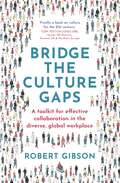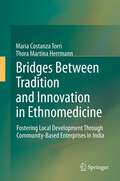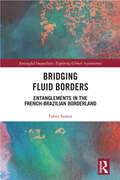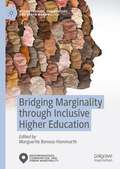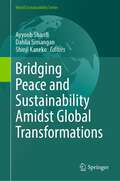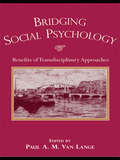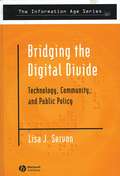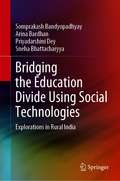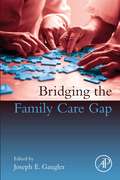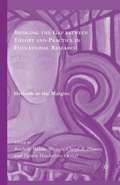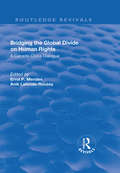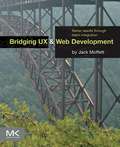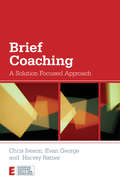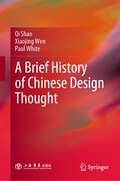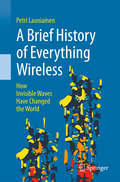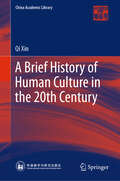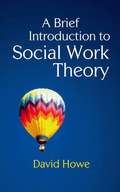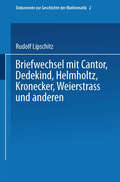- Table View
- List View
Bridge the Culture Gaps: A toolkit for effective collaboration in the diverse, global workplace
by Robert GibsonThe essential guide for working in diverse teams and across cultures today. This practical self-help guide will optimize the performance of individuals and teams working in an intercultural environment. By increasing awareness of the nature and impact of diversity in the workplace and national cultural differences, it demonstrates how to use the power of difference to achieve positive results for all. Learn how to mitigate unconscious bias to create inclusive organizations and how to use key cultural dimensions to communicate and cooperate in intercultural teams. Addressing the unique challenges of influencing across cultures and managing international transformation projects, this is an indispensable toolkit for a key competence in business.Leading interculturalist Robert Gibson challenges conventional ideas and makes new connections between culture, diversity and neuroscience in this modern guide for anyone working virtually or together in a diverse team or international business. Use these simple and proven approaches for better communication, collaboration, leadership and decision making in today's globalised workplace.
Bridges Between Tradition and Innovation in Ethnomedicine: Fostering Local Development Through Community-Based Enterprises in India
by Maria Costanza Torri Thora Martina HerrmannCommunity-based enterprises are the result of a process in which the community acts entrepreneurially to create and operate a new enterprise embedded in its existing social structure and network. This book argues that community-based enterprise could represent a strategy for fostering sustainable local development while at the same time maintaining traditional knowledge in ethnomedicine and conserving the local ecosystems.
Bridging Fluid Borders: Entanglements in the French-Brazilian Borderland (Entangled Inequalities: Exploring Global Asymmetries)
by Fabio SantosInterweaving rich ethnographic descriptions with an innovative theoretical approach, this book explores and unsettles conventional maps and understandings of Europe and the Americas. Through an examination of the recently inaugurated cross-border bridge between France’s overseas department of French Guiana and Brazil’s northern state of Amapá, which effectively acts as a one-way street and serves to perpetuate inequalities in a historically deeply entangled region, it foregrounds the ways in which borderland inhabitants such as indigenous women, illegalised migrants, and local politicians deal with these inequalities and the increasingly closed Amazonian border in everyday life. A study that challenges the coloniality of memory, this volume shows how the borderland along and across the Oyapock River, far from being the hinterland of France and Brazil, in fact illuminates entangled histories and their concomitant inequalities on a large scale. As such, it will appeal to scholars of sociology and border studies with interests in postcolonialism, memory, and inequality.
Bridging Fluid Borders: Entanglements in the French-Brazilian Borderland (Entangled Inequalities: Exploring Global Asymmetries)
by Fabio SantosInterweaving rich ethnographic descriptions with an innovative theoretical approach, this book explores and unsettles conventional maps and understandings of Europe and the Americas. Through an examination of the recently inaugurated cross-border bridge between France’s overseas department of French Guiana and Brazil’s northern state of Amapá, which effectively acts as a one-way street and serves to perpetuate inequalities in a historically deeply entangled region, it foregrounds the ways in which borderland inhabitants such as indigenous women, illegalised migrants, and local politicians deal with these inequalities and the increasingly closed Amazonian border in everyday life. A study that challenges the coloniality of memory, this volume shows how the borderland along and across the Oyapock River, far from being the hinterland of France and Brazil, in fact illuminates entangled histories and their concomitant inequalities on a large scale. As such, it will appeal to scholars of sociology and border studies with interests in postcolonialism, memory, and inequality.
Bridging Marginality through Inclusive Higher Education (Neighborhoods, Communities, and Urban Marginality)
by Marguerite Bonous-HammarthThis book examines the changing influences of diversity in American higher education. The volume offers evidence and recommendations to positively shape inclusive learning and engagement of students, faculty, staff and community across the complex terrains of urban, suburban, and rural organizations within higher education today. Chapters highlight critical collaborations across student affairs and academic affairs, and delve into milestones addressing access, retention, engagement, and thriving within distinctive institutional types (e.g., research, liberal arts, community colleges, Minority Serving Institutions). Authors also explore the nuanced changes occurring against the contemporary backdrop of COVID-19 experiences – including the rise of anti-Asian racism, the salience of implicit biases, and the disparate access to and impacts of health services. Essential chapters refocus our consideration about the trajectories of historically underrepresented groups and their peers (including, African Americans, Hispanic/Latino, Indigenous people, individuals with disabilities and those identifying as LGBTQ+, undocumented students, and women) in American higher education.
Bridging Occupational, Organizational and Public Health: A Transdisciplinary Approach
by Georg F. Bauer Oliver HämmigIn our complex, fast changing society, health is strongly influenced by the continuously changing interactions between organisations and their employees. Three major fields contribute to health-oriented improvements of these interactions: occupational health, organizational health and public health. As currently only partial links exist amongst these fields, the book aims to explore potential synergies more systematically. Considering the high mental and social demands in a service and knowledge sector economy, the first part of the book focuses on work-related psychosocial factors. As a large proportion of inequalities in health in developed countries can be explained by inequalities in working conditions, those psychosocial factors with a particularly high public health impact are highlighted. As addressing these psychosocial factors requires to involve the organization as the key change agent, the second part covers approaches to improve public health through organizational level health interventions. The last section takes a look into the future of occupational, organizational and public health: what are the future challenges regarding occupational health and how can they be tackled within and beyond the organizational level. Overall, this integrating book will help to broaden the evidence-base, legitimacy and efficacy of occupational- and organizational-level health interventions and thus increase their public health impact.
Bridging Peace and Sustainability Amidst Global Transformations (World Sustainability Series)
by Ayyoob Sharifi Dahlia Simangan Shinji KanekoThis book is the sequel to a well-received book titled ‘Integrated Approaches to Peace and Sustainability’ that aims to further advance the understanding of the dynamic interactions between various components of peace and sustainability. How are peace and sustainability linked to each other, and what are the key parameters that define the nexus between them? This book addresses those questions through a combination of theoretical studies and empirical research that contextualize peace and sustainability issues amid global transformations. The conceptual and empirical linkages between peace and sustainability are widely recognized in academic and policy circles. The adoption of the 2030 Agenda for Sustainable Development confirms this recognition. However, many of the initiatives on peace and sustainability operate in silos, undermining the positive and mutually reinforcing relationship between them. Enhanced integration of peace and sustainability components is imperative for addressing complex challenges that come with global transformations that are manifested environmentally, socially, politically, and economically across levels. It is, therefore, crucial to identify the pathways that enhance the peace-promoting potential of sustainability and the sustainability-promoting potential of peace. The contributions in this edited book elaborate on such pathways by offering insights related to different social, economic, and environmental aspects of the peace-sustainability nexus. Given its inter- and trans-disciplinary focus, the book is of interest to policymakers and researchers working in different areas of peace and sustainability. It contributes to ongoing academic and policy discussions surrounding the outcomes of and challenges to achieving the Sustainable Development Goals (SDGs), particularly SDG 16 on peace, justice and strong institutions.
Bridging Social Psychology: Benefits of Transdisciplinary Approaches
by Paul A. M. Van LangeBridging Social Psychology illuminates the unique contribution the field of social psychology can bring to understanding major scientific and societal problems. The book focuses on illustrating the benefits and costs of bridging social psychology with other fields of psychology, including cognitive, developmental, and personality psychology, as well as other disciplines such as biology, neuroscience and economics. The editor’s hope is that the examination of these bridges will result in new theoretical, methodological, and societal benefits. The 65 essays, written by eminent leaders in the field, demonstrate the relationship of social psychology with: (1) biology, neuroscience and cognitive science; (2) personality, emotion, and development; (3) relationship science, interaction, and health; and (4) organizational science, culture, and economics. The book also examines the key assumptions of social psychology, where the field is headed, and its unique contribution to basic theoretical and broad societal questions (e.g. promoting health in society). Section introductions tie the book together. The book concludes with an enlightening Epilogue by Walter Mischel.This book will appeal to scholars, researchers, and advanced students in social psychology wishing to demonstrate the cross-disciplinary aspect of their research. It will also be of interest to those in neighboring fields of psychology, especially personality, organizational, health, cognitive, and developmental psychology, as well as those in neuroscience, biology, sociology, communication, economics, political science, and anthropology. The user-friendly tone makes the book accessible to those with only a basic knowledge of social psychology. The book also serves as a text for advanced courses in social psychology and/or applied psychology. A helpful table, found on the book’s Web site, indicates the cross-disciplinary applications addressed in each essay, to make it easier to assign the book in courses.
Bridging Social Psychology: Benefits of Transdisciplinary Approaches
by Paul A. M. Van LangeBridging Social Psychology illuminates the unique contribution the field of social psychology can bring to understanding major scientific and societal problems. The book focuses on illustrating the benefits and costs of bridging social psychology with other fields of psychology, including cognitive, developmental, and personality psychology, as well as other disciplines such as biology, neuroscience and economics. The editor’s hope is that the examination of these bridges will result in new theoretical, methodological, and societal benefits. The 65 essays, written by eminent leaders in the field, demonstrate the relationship of social psychology with: (1) biology, neuroscience and cognitive science; (2) personality, emotion, and development; (3) relationship science, interaction, and health; and (4) organizational science, culture, and economics. The book also examines the key assumptions of social psychology, where the field is headed, and its unique contribution to basic theoretical and broad societal questions (e.g. promoting health in society). Section introductions tie the book together. The book concludes with an enlightening Epilogue by Walter Mischel.This book will appeal to scholars, researchers, and advanced students in social psychology wishing to demonstrate the cross-disciplinary aspect of their research. It will also be of interest to those in neighboring fields of psychology, especially personality, organizational, health, cognitive, and developmental psychology, as well as those in neuroscience, biology, sociology, communication, economics, political science, and anthropology. The user-friendly tone makes the book accessible to those with only a basic knowledge of social psychology. The book also serves as a text for advanced courses in social psychology and/or applied psychology. A helpful table, found on the book’s Web site, indicates the cross-disciplinary applications addressed in each essay, to make it easier to assign the book in courses.
Bridging the Digital Divide: Technology, Community and Public Policy (Information Age Series)
by Lisa J. ServonBridging the Digital Divide investigates problems of unequal access to information technology. The author redefines this problem, examines its severity, and lays out what the future implications might be if the digital divide continues to exist. Examines unequal access to information technology in the United States. Analyses the success or failure of policies designed to address the digital divide. Draws on extensive fieldwork in several US cities. Makes recommendations for future public policy. Series editor: Manuel Castells.
Bridging the Education Divide Using Social Technologies: Explorations in Rural India
by Somprakash Bandyopadhyay Arina Bardhan Priyadarshini Dey Sneha BhattacharyyaThis book explains the concept of education divide in rural India and identifies various factors that shape and sustain such a divide. In doing so, it also discusses a range of attempts undertaken to bridge the education divide. Subsequently, the book has attempted in providing a socio-technical framework towards optimally deploying social technologies for addressing the issue of education divide of marginalized communities. The proposed framework offers a transition from traditional content-centric, teacher-centric and centralized education ecosystem to a connection-centric, learner-centric and decentralized education ecosystem of the socio-digital age. It demonstrates how Internet-enabled digital platforms, based on the principles of sharism and mass collaboration using social technologies, could help to solve one of the greatest problems facing the world: mitigating the extant education divide by delivering quality education to underprivileged sections of society. The book also presents empirical validation of the proposed framework to show how a community-driven blended learning platform can mobilize the dormant knowledge capital of domain experts to teach underprivileged rural Indian children, as well as help form communities of practice to enable lifelong learning for the rural adult population. The book closes by pointing out the challenges involved in building an equitable education ecosystem using social technologies and ultimately the possibility of creating a fair and equitable society. Given its scope, the book offers a valuable resource for researchers, policymakers and practitioners in the domain of education who want to transform education ecosystems by using technological and process-related innovations to improve educational practices for underprivileged sections of society.
Bridging the Family Care Gap
by Joseph E. GauglerBridging the Family Care Gap explores expected future shortages of family caregivers of older persons and identifies potential solutions. The book examines the sustainability and availability of care management models and whether they can be effectively scaled up to meet community needs. It identifies newly emerging policy initiatives at local, state, and federal levels. The book addresses the state of family caregiving science, dissemination and implementation of promising programs and supports, technological innovations, and other strategies to offset the family care gap. This edited volume also explores lay healthcare workers as guides, interpreters, and advocates in healthcare systems that provide continuity of contact for family caregivers.Details threats to family caregiving-sociodemographic, chronic disease, and socioeconomic challengesPresents solutions to the caregiving gap in a systematic, synthesized mannerAddresses the intersection of family caregiving and technologyDiscusses chronic disease management to offset and reduce the need for family caregivingDescribes models of caregiver support in work settingsReimagines the delivery of long-term services and supports with novel initiatives
Bridging the Gap between Theory and Practice in Educational Research: Methods at the Margins
by Rachelle Winkle-Wagner Cheryl A. HunterThis book provides new ways of thinking about educational processes, using quantitative and qualitative methodologies. Ultimately, it aims at expanding knowledge itself - altering the centre by allowing the margins to inform it - allowing it to be extended to include those ways of knowing that have historically been unexplored or ignored.
Bridging the Global Divide on Human Rights: A Canada-China Dialogue
by Errol P. Mendes Anik Lalonde-RoussyThis title was first published in 2003. In this collection of essays that explores Western and Chinese perspectives on human rights, leading Canadian and Chinese scholars bridge the global divide on some of the key aspects of human rights. Issues covered include the role of civil society in human rights protection, the imperative of the rule of law in the protection of human rights, freedom of expression and its relation to social, economic and cultural development and corruption in the public and private sectors. The volume also focuses on the domestic implementation of human rights treaties and offers gender perspectives on implementing social and economic rights in an era of globalization. The independent Chinese and Canadian scholars present a new vision of global pluralism in the area of human rights protection in a modernizing China and in the rest of the world.
Bridging the Global Divide on Human Rights: A Canada-China Dialogue (Routledge Revivals Ser.)
by Errol P. Mendes Anik Lalonde-RoussyThis title was first published in 2003. In this collection of essays that explores Western and Chinese perspectives on human rights, leading Canadian and Chinese scholars bridge the global divide on some of the key aspects of human rights. Issues covered include the role of civil society in human rights protection, the imperative of the rule of law in the protection of human rights, freedom of expression and its relation to social, economic and cultural development and corruption in the public and private sectors. The volume also focuses on the domestic implementation of human rights treaties and offers gender perspectives on implementing social and economic rights in an era of globalization. The independent Chinese and Canadian scholars present a new vision of global pluralism in the area of human rights protection in a modernizing China and in the rest of the world.
Bridging UX and Web Development: Better Results through Team Integration
by Jack MoffettThe divide between UX and Web development can be stifling. Bridging UX and Web Development prepares you to break down those walls by teaching you how to integrate with your team’s developers. You examine the process from their perspective, discovering tools and coding principles that will help you bridge the gap between design and implementation. With these tried and true approaches, you’ll be able to capitalize on a more productive work environment. Whether you’re a novice UX professional finding your place in the software industry and looking to nail down your technical skills, or a seasoned UI designer looking for practical information on how to integrate your team with development, this is the must-have resource for your UX library.Establish a collaboration lifecycle, mapping design activities to counterparts in the software development processLearn about software tools that will improve productivity and collaborationWork through step-by-step exercises that teach font-end coding principles to improve your prototyping and implementation activitiesDiscover practical, usable HTML and CSS examplesUncover tips for working with various developer personas
Brief Coaching: A Solution Focused Approach (Essential Coaching Skills and Knowledge)
by Chris Iveson Evan George Harvey RatnerBrief Coaching offers a new approach to coaching by considering how the client will know when they have reached their goal, and what they are already doing to get there. The coach aims to work towards the solution rather than working away from the problem, so that the client's problem is not central to the session, but instead the coach and the client work towards the client's preferred future. This book employs case examples and transcripts of sessions to offer guidance on: looking for resources rather than deficits exploring possible and preferred futures examining what is already contributing to that future treating clients as experts in all aspects of their lives. This practical guide includes summaries and activities for the coach to do with the client and will therefore be a useful tool for both new and experienced coaches, as well as therapists branching into coaching who want to add to their existing skills.
Brief Coaching: A Solution Focused Approach (Essential Coaching Skills and Knowledge)
by Chris Iveson Evan George Harvey RatnerBrief Coaching offers a new approach to coaching by considering how the client will know when they have reached their goal, and what they are already doing to get there. The coach aims to work towards the solution rather than working away from the problem, so that the client's problem is not central to the session, but instead the coach and the client work towards the client's preferred future. This book employs case examples and transcripts of sessions to offer guidance on: looking for resources rather than deficits exploring possible and preferred futures examining what is already contributing to that future treating clients as experts in all aspects of their lives. This practical guide includes summaries and activities for the coach to do with the client and will therefore be a useful tool for both new and experienced coaches, as well as therapists branching into coaching who want to add to their existing skills.
A Brief History of Chinese Design Thought
by Qi Shao Xiaojing Wen Paul WhiteThis book introduces readers to the history of design thinking in pre-modern China. The content is structured according to successive dynasties, covering the seven major periods of the pre-Qin, Qin and Han, Wei and Jin, Sui and Tang, Song and Yuan, Ming, and Qing dynasties. Each chapter introduces the most representative individuals of the period and discusses their work and ideas in order to reveal the national and cultural features of the respective periods. A distinctive feature of cultural identity running through the long course of China’s historical development is the argument that actions are determined by ideas: Such a view can be found in long-standing thinking on art, design, and creativity. The book demonstrates that conscious design is the vital link between the ideas that constitute human cultures and the physical objects that make up their resulting material cultures. It is the attribute of design that defines what it is to be human and also produces the physical evidence of the evolution of Chinese civilization. The book reveals the integrated characteristics of Chinese culture and art and shows how both changing and recurring ideologies have influenced Chinese design practice since the ancient Shang and Zhou dynasties and how these forces have shaped the spirit and materiality of Chinese civilization. Design is the cornerstone that has made China one of the major contributors to human civilization throughout the thousands of years of its history.Given its focus, the book largely appeals to two main audiences: an academic readership of students and researchers interested in cultural studies and, a more general one, consisting of those interested in international comparisons and wishing to learn more about Chinese history, society, and culture. In order to appeal to both, the book is written in a clear and accessible language.
A Brief History of Everything Wireless: How Invisible Waves Have Changed the World
by Petri LauniainenSince the discovery of electromagnetic waves less than 150 years ago, the application of wireless communications technology has not only revolutionized our daily lives, but also fundamentally changed the course of world history.A Brief History of Everything Wireless charts the fascinating story of wireless communications. The book leads the reader on an intriguing journey of personal triumphs and stinging defeats, relating the prominent events, individuals and companies involved in each progressive leap in technology, with a particular focus on the phenomenal impact of each new invention on society. Beginning at the early days of spark-gap transmitters, this tale touches on the emergence of radio and television broadcasting, as well as radio navigation and radar, before moving on to the rise of satellite, near-field and light-based communications. Finally, the development of wireless home networks and the explosive growth of modern cellular technologies are revealed, complete with a captivating account of their corresponding company histories and behind-the-scenes battles over standards.For those wishing to peek behind the magic curtain of friendly user interfaces and clever engineering, and delve further into various processes underlying the ubiquitous technology we depend upon yet take for granted, the book also contains special “TechTalk” chapters that explain the theoretical basics in an intuitive way.
A Brief History of Human Culture in the 20th Century (China Academic Library)
by Qi XinThis book examines the cultural concepts that guided the development of the “age of mankind”— the changes that took place in historical, philosophical, scientific, religious, literary, and artistic thought in the 20th century. It discusses a broad range of major topics, including the spread of commercial capitalism; socialist revolutions; the two world wars; anti-colonialist national liberation movements; scientific progress; the clashes and fusion of Eastern and Western cultures; globalization; women’s rights movements; mass media and entertainment; the age of information and the digital society. The combination of cultural phenomena and theoretical descriptions ensures a unity of culture, history and logic. Lastly, the book explores the enormous changes in lifestyles and the virtualized future, revealing cultural characteristics and discussing 21st -century trends in the context of information technology, globalization and the digital era.
A Brief History of Schooling in the United States: From Pre-Colonial Times to the Present (The Cultural and Social Foundations of Education)
by Edward JanakThis book presents a sweeping overview of the historical and philosophical foundations of schooling in the United States. Beginning with education among the indigenous peoples of the Americas and going on to explore European models of schooling brought into the United States by European colonists, the author carefully traces the arc of educational reform through major episodes of the nation’s history. In doing so, Janak establishes links between schools, politics, and society to help readers understand the forces impacting educational policy from its earliest conception to the modern day. Chapters focus on the philosophical, political, and social concepts that shaped schooling of dominant and subcultures in the United States in each period. Far from being merely concerned with theoretical foundations, each chapter also presents a snapshot of the “nuts and bolts” of schooling during each period, examining issues such as pedagogical devices, physical plants, curricular decisions, and funding patterns.
A Brief Introduction To Social Work Theory (PDF)
by David HoweLearning about social work theory is a bit like hot air ballooning - it's about looking at the world from above and going on a voyage of discovery to find out what guides social work practice. In 25 clearly labelled chapters, this book explains and discusses social work theory in a crisp, clear and accessible way. Whether you're a student, a newly qualified social worker or a 'seasoned' professional you will find plenty in this book to inform, enlighten and refresh you. Written by David Howe, one of the top British writers in social work, his simple, easy-to-read style makes this text ideal for quick reference in lectures, on placement or in practice. A Brief Introduction to Social Work Theory manages to be both compact and comprehensive. You will return to this 'can't live without it' text time and time again.
Briefwechsel: Band 1 (René König Schriften. Ausgabe letzter Hand #19)
by Mario König Oliver KönigVon René König liegt ein umfangreicher Briefwechsel vor, der von den 20er bis 90er Jahre reicht. Er verdeutlicht die Vielfalt der persönlichen, intellektuellen und beruflichen Freundschaften und Kontakte, die mit dem ebenso umfangreichen wie vielseitigen wissenschaftlichen, literarischen und journalistischpopulären Werk verbunden sind. Die Schriftenreihe legt eine Auswahl dieses Briefwechsels in zwei Bänden vor. Der erste Band umfasst den gegenseitigen Briefverkehr von René König mit zentralen Vertretern der Soziologie in der Gründungsphase nach dem 2. Weltkrieg: Theodor W. Adorno, Max Horkheimer, Helmut Schelsky, Otto Stammer, Leopold von Wiese. Die Zeit der Neubegründung der Soziologie in Deutschland nach dem 2. Weltkrieg ist nicht nur fachsoziologisch, sondern auch zeitgeschichtlich von Interesse, da die exponierten Vertreter der Soziologie in diesen Jahren wesentliche gesellschaftliche und kulturelle Positionen repräsentierten und auch gesellschaftlich auf die Entwicklung der Bundesrepublik Einfluss zu nehmen versuchten. Der vorliegende Briefwechsel beschäftigt sich mit inhaltlich-fachlichen, universitäts- sowie institutionspolitischen Fragen im Zusammenhang mit der 1946 wiedergegründeten Deutschen Gesellschaft für Soziologie (DGS).
Briefwechsel mit Cantor, Dedekind, Helmholtz, Kronecker, Weierstrass und anderen (Dokumente zur Geschichte der Mathematik #2)
by Rudolf LipschitzEin Abdruck des gesamten Briefwechsels würde etwa 1500 Seiten erfordern, kam also nicht in Betracht. Es wurde versucht, die interessantesten Briefe herauszusuchen, aber die getroffene Aus wahl ist sicher subjektiv und teilweise willkürlich. Es wurde nicht einmal versucht, nach formal einheitlichen Kriterien vor zugehen. Z. B. wurde der Briefwechsel mit Dedekind und Kronecker in großen Teilen vollständig aufgenommen, weil hier auch Lipschitz' Briefe vorhanden sind und vor allem der Briefwechsel mit Dedekind historisch von besonderer Bedeütung ist. Aus ande ren Korrespondenzen wurden oft nur einzelne Briefe oder Teile einzelner Briefe ausgewählt. Gelegentlich werden in eckigen Klammern kurze Angaben über den Inhalt ausgelassener Passagen gemacht. Im Prinzip wurde der Originaltext buchstabengetreu übernommen einschließlich orthographischer Fehler und der ur sprünglichen Interpunktion; offensichtliche Versehen wurden allerdings meistens verbessert. Fußnoten und Anmerkungen sind jeweils nach den einzelnen Korrespondenzen zusammengefaßt. - 2 - Brief von Cantor (Auszug); vgl. S. 29 bis 3; - 3 - - 4 - 7. ~ ;;LL. . . #-~r ~ ~'v ~'~ a. /~ ~ r ~ . /' . . . . . . !v-d~r 4Vh'. ,-. . . ,4. ~ ~~ r'-~ . . . . 'v-/}-~
